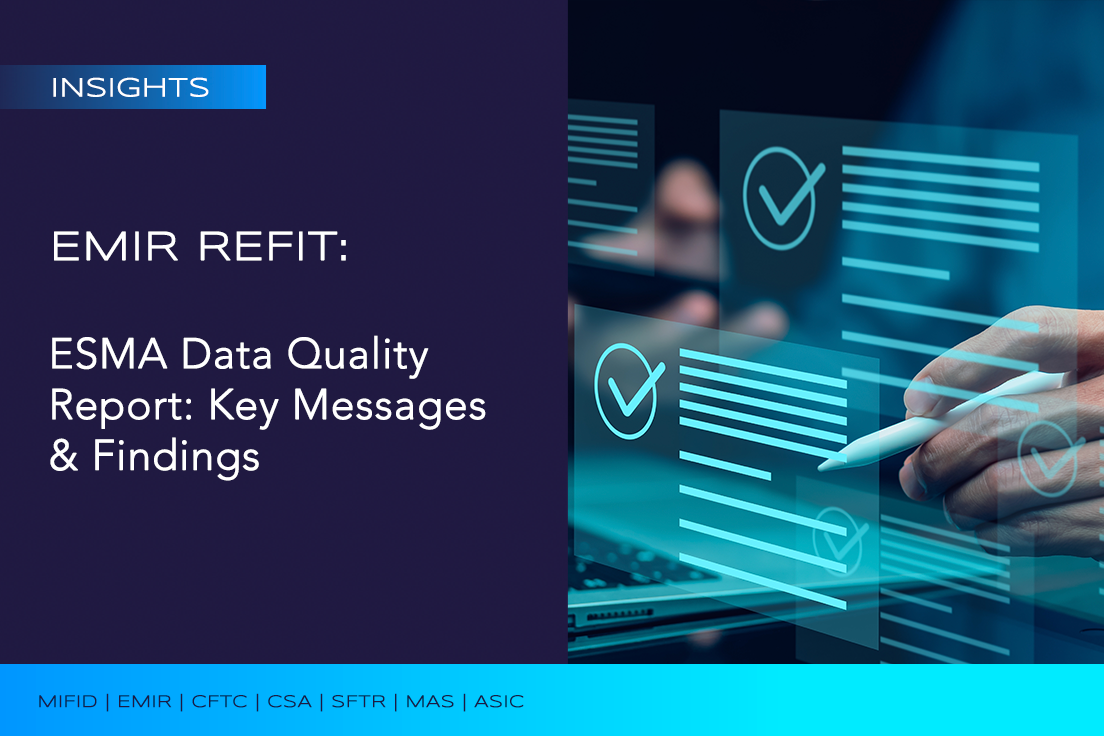 Author:
Dan Fletcher
Author:
Dan Fletcher
Transaction Reporting Manager
1 October 2025
In April 2025, the European Securities and Markets Authority (ESMA) has published the fifth edition of its report on the quality and use of regulatory data.
Since the go-live of EMIR REFIT on 29 April 2024, the European derivatives reporting regime has undergone a major transformation.
EMIR REFIT has been more than a technical upgrade, it's a fundamental shift in how data is validated, monitored and enforced.
ESMA's sharpened focus on data quality means that compliance is not longer about just submitting data, it's about submitting accurate and timely data.
Data Quality Indicators (DQIs) are metrics developed by ESMA to assess the accuracy, completeness, and consistency of reported derivatives data.
Below are some of the key findings of ESMA's data quality report pertaining to EMIR REFIT followed by our interpretation of the findings based on our interactions with market participants and their challenges with data quality.
Data Quality Under EMIR REFIT - ESMA's Top Findings
Number of Outstanding Trades
- Improved from 33.91% (May 2024) to 20.5% (Dec 2024).
- This indicator quantifies discrepancies in the number of reported outstanding derivatives at the trade level between two counterparties engaged in trading.
- These discrepancies distort exposure assessments and must be resolved.
Our take: The downward trend, in the roughly six months in 2024, could be due to a bedding-in process.
ESMA also observed that "[...] ESMA and authorities supervising the reporting entities noted the different levels of preparedness of reporting entities but also TRs. [..] More specifically on TRs preparedness, ESMA and authorities observed that some key functionalities had been delivered after the go-live."
We were curious if the lack of some TRs not being ready for Go-Live and introducing more changes post-Go Live may have affected the number of Outstanding Trades not matching between counterparties. If data is not being shared between TRs, then this is one area that would be affected.
We will be watching these indicators for further improvements. ESMA doesn't provide historical data on this indicator.
Number of Outstanding Positions
- Improved from 55.16% to 22.17%.
- This tracks inconsistencies in reported outstanding between counterparties subject to double reporting.
- Indicates better alignment but still above acceptable thresholds.
Our Take: Again, as in the point above, we wondered if this too was due to bedding-in process and the discrepancies more related to a lack of preparedness of reporting entities and TRs.
Outdated Validations
- Dropped from roughly 30% to 16.19%.
- Captures trades with not updated valuation data.
- The absence of up-to-date valuations limits authorities' ability to monitor exposures, especially during crises.
Our take: The improvement is likely linked to greater awareness around the expectation of stale valuations. ESMA guidelines for EMIR Refit were quite clear in outlining expectations for daily valuations and what it would consider a stale valuation. As supervisory guidance and industry awareness improved, firms adjusted their processes, resulting in more consistent and timely valuation data.
Blank or Abnormal Maturity Dates
- Stands slightly above 10%.
- Includes trades with missing maturities or those exceeding 51 years. These erros can cause expired trades to be misclassified as active.
- ESMA expects this to decline following corrective actions.
Our take: This may be due to sloppy data collection on the part of reporting counterparty. For some instruments, especially those that are perpetual, we have seen dummy maturity dates, in the past. More industry awareness appears to be correcting this issue.
Missing Valuations
- Recently increased to 12.63%.
- the absence of data in this crucial field directly impacts authorities' ability to monitor exposures accurately.
- ESNA and NCAs are closely monitoring this trend.
Our take: The decline is likely linked to the changes introduced under EMIR Refit regarding which counterparty is responsible for submitting daily valuations. Initially, this shift created some confusion, with counterparties unclear on their obligations to report valuations. As supervisory guidance and industry awareness improved, firms adjusted their processes, resulting in more consistent and timely submission of valuation data.
Incorrect Entity Responsible for Reporting
- At 1.36%, below the 5% threshold identifies trades with misreported reporting party information.
- Entity Responsible for Reporting was a key addition to EMIR Refit reporting therefore EMSA included statistics even though the error rate appears quite low, that is, under the 5 % threshold.
Our take: We thought, for a new addition, the error rate was quite good. With any new field, there is always a bedding-in process and there may have been some confusion around the field and a counterparty’s reporting obligation. We speculated that perhaps some entities may have auto-populated this field without properly consider the default obligations of FCs in relation to NFC -/+.
The quality of data submitted has improved in some respects but arguably the improvement was made from a low starting point. Market participants can therefore expect to see ESMA push for further improvement in the quality of data being submitted to comply with EMIR/EMIR Refit transaction reporting requirements.


